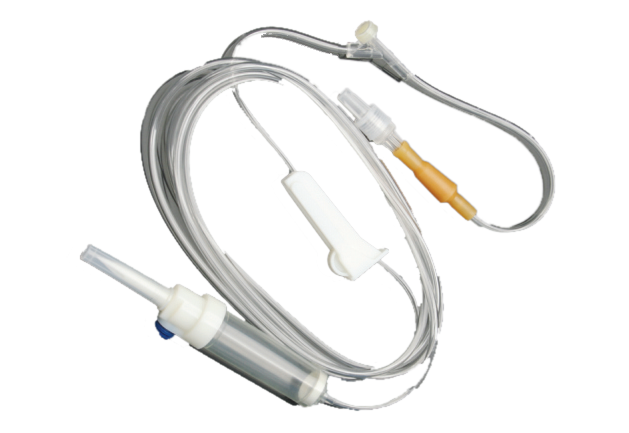
Infusion Sets / IV Sets
If you’re living with diabetes, you’ve likely heard of the term “infusion set.” But what exactly is it and why do you need one? In this article, we explore the basics of an infusion set – from its components to its purpose – so that you can make more informed decisions about your diabetes management.
Sharp ABS spike with protection cap, big drip chamber with integrated bacteria-proof air vent, with liquid filter 20 micron, luer lock connector, synthetical rubber flash ball, with Y injection site, samll ABS precision flow regulator, without hypodermic needle.
An infusion set is a small, disposable device that is used to deliver insulin to your body through an insulin pump. It consists of a thin, plastic tube (catheter) that is inserted under the skin on your abdomen, hip, or buttocks and threaded through to the insulin pump. The other end of the catheter is connected to an infusion port, which is where the insulin is delivered. The infusion set also includes a needle that is used to insert the catheter into your skin and a cannula (a small, hollow tube) that goes under your skin and delivers the insulin.
A pump is a mechanical device that moves fluids, or gases, by physical force. Pumps can be classified into three major groups according to the method they use to move the fluid: direct lift, displacement, and gravity pumps. Pumps are used in many industries for a variety of purposes. For example, pumps are used in the food and beverage industry to move liquids through processing lines, in the automotive industry to circulate coolant and lubricants, and in the construction industry to remove water from excavations.
An infusion set is a small, disposable device that helps deliver insulin to your body through your pump. It’s made up of a few parts:
• A cannula (a small, thin tube) that goes just under your skin
• An infusion site (where the cannula is inserted)
• A tubing system that connects the infusion site to your insulin pump
You’ll need to change your infusion set every few days, depending on the type of set you use. Infusion sets are not one size fits all—there are different types of sets for different body types and activities. Your diabetes team will help you figure out which type of set is best for you.
An infusion set is a small, sterile tube that is used to deliver insulin from an insulin pump to your body. The size of a typical infusion set is about the same as a thin straw.
An infusion set is a small, sterile tube that's inserted underneath the skin to deliver insulin directly into your body. It's connected to an insulin pump, which is a small, computerized device that's worn outside the body. The pump sends insulin through the tubing and into your body on a regular basis. You'll need to change your infusion set or needles every few days, depending on the type of insulin you're using and how often you need it. Your doctor or diabetes educator will help you figure out how often to change your infusion set or needles. When it's time to change your infusion set or needles, here's what you'll need to do:
1. Wash your hands with soap and water.
2. Remove the old infusion set or needle from your body.
3. Dispose of the old infusion set or needle properly (ask your doctor or diabetes educator for instructions on how to do this).
4. Insert the new infusion set or needle into your body.
5. Connect the new infusion set or needle to your insulin pump.
6. Test your blood sugar levels regularly (ask your doctor or diabetes educator how often to do this).
An infusion set is a crucial component of any insulin pump, and it is important to keep your infusion set clean and free from infection. Here are some tips for preventing infection:
-Wash your hands thoroughly with soap and water before handling your infusion set.
-Always use a new needle when inserting your infusion set.
-Change your infusion set every 3 days or as directed by your healthcare provider.
-Keep the insertion site clean and dry. Apply an alcohol swab to the area before inserting the needle.
-Inspect the needle and tubing regularly for any signs of redness, swelling, or discharge. If you see any of these signs, discontinue use and contact your healthcare provider.